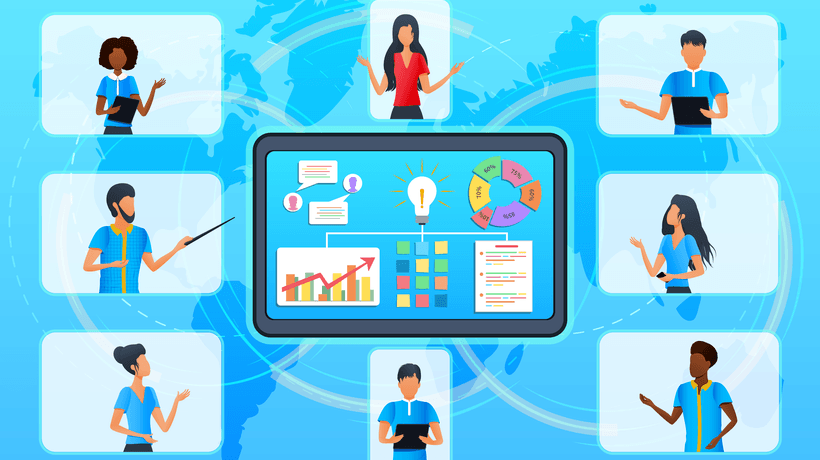Four Ways Quality L&D Experiences Drive Retention
Unprecedented events and lasting transformations inspire people to question their lives and whether they’re doing enough for themselves and their communities. But they also ponder whether they’re getting enough in return and if their work correlates with their compensation, benefits, and expectations.
This has encouraged many employees to reflect on their work experience and ask whether there’s more to it. The pandemic aftermath has forced people to question whether work should be only about performing their daily tasks and receiving a paycheck, or whether the time spent in offices should add value and help them grow personally and professionally.
Working and living through the COVID-19 crisis and social and economic challenges have prompted them to prioritize fulfillment, development, and purposefulness. People understand it’s no longer enough to settle for the minimum and expect employers only to provide regular salaries and benefits.
Instead, companies should go beyond the elementary work perks and conditions. They should understand employees’ potential and help them nurture it. This gave rise to new workers’ expectations and demands, forcing businesses to reevaluate their workforce models, strategies, and values. Otherwise, they risk losing stellar talents and failing to develop future leaders and top performers.
How Have The Recent Crises Transformed Employees L&D Expectations?
The Great Resignation has become one of the most talked about consequences of the pandemic. However, many professionals claim this phenomenon would happen regardless of the crisis, calling it the Great Reshuffle instead. They believe the pandemic has revealed workplace cracks and issues and made them impossible to ignore. Employees started quitting their jobs faster due to accumulated dissatisfaction and neglected needs. According to the Pew Research Center, 37% quit because the pay was too low, and 35% felt disrespected. However, many people put up with disappointing conditions before the pandemic due to feeling they had no other choice.
The COVID-19 crisis confronted us with our mortality and forced us to question whether we’re happy with our lives, or want more from what we have. After remembering how short and fragile human life is, we understood we shouldn’t waste it on things that don’t add genuine value or fulfill us. Moreover, the job market was different before the pandemic, leaving job seekers with more limited job prospects. Many workers held on to their jobs, even when they were not paid enough or their employers didn’t address employees’ needs. But their possibilities increased during the pandemic, as people resigned from their jobs, leaving companies with empty vacancies.
As a result, the US economy had more job openings than expected in July 2022 [1]. Over 11.2 million jobs were available during the summer, yet there were not enough job seekers who would take these opportunities [1]. LinkedIn’s recent survey has shown that 63% of recruiters say talent shortage is their biggest problem [2]. Once candidates could choose between various job openings, they had a chance to be more selective and strive toward opportunities aligned with their expectations, needs, and standards. This allowed job seekers and employees to only accept working with companies with the same values and objectives.
But it also made people more demanding regarding their career growth, learning, and development. Today, many employees will decline a job offer if the employer offers no training or educational programs [2]. For instance, 33% of people quit their jobs in 2021 due to no professional advancement opportunities. Even though companies are changing their Learning and Development (L&D) strategies and hope to improve their offering, there’s still a long way to go. Here’s why that could lead to employee disengagement and turnover.
Poor L&D Experiences Lead To Employee Turnover And Disengagement
Salaries, unique perks, and benefits are no longer the most attractive competitive differentiator. Today, that title belongs to Learning and Development and career growth. As a result, L&D shouldn’t be a background program only or a nice-to-have. Companies that strive to attract top talents and keep their employees happy and successful must provide well-rounded employee training and educational opportunities.
Employees always wanted to have the option to grow and learn in their workplaces, but now they can finally demand this louder. Access to L&D could stop people from quitting their jobs as they aim to become their best selves and pursue their ambitions. Because of this, employers have more complex responsibilities in the post-pandemic world and must have well-rounded learning options. But increased employee expectations are not the only reason companies should introduce efficient L&D programs.
These opportunities are also necessary to help workers keep up with emerging trends, technologies, and unexpected global events. The complexity of today’s world requires companies to update their employee training practices and offer up-to-date solutions continuously. Technology changes fast, and those who can’t adapt will stay behind. Moreover, workers without access to modern learning programs will struggle to adopt relevant skills, learn to use advanced tech, and navigate the professional world. For instance, 55% say they need additional training to perform better in their jobs, and 32% believe employee training should be updated regularly [3]. However, that often doesn’t happen, and one in two workers pursues learning opportunities outside the workplace [3].
But since 68% of employees consider training and development essential to job satisfaction, a lack of these opportunities could cause disengagement. When unhappy about their growth possibilities in the company, workers often lose motivation and see no reason to put in the effort. According to the latest LinkedIn report, opportunities to learn and grow are the number one driver of great company culture.
Well-thought-out and engaging learning experiences inspire people to stay in their workplaces and find joy in their jobs. They give them a reason to pursue their goals and strive for professional advancement in their companies. If no L&D programs are available, employees will struggle with morale and seek better opportunities elsewhere. Hence, developing L&D programs and experiences is necessary to nurture retention.
How To Create Quality L&D Experiences That Stimulate Retention?
1. Create Useful And Relevant L&D Experiences
No one likes the traditional learning models with outmoded practices and expectations, forcing learners to sit and try to memorize theoretical concepts. These experiences are disengaging, tiring, and rarely useful. Employees should have modern and immersive training focused on their unique needs and objectives. It should be relevant, up-to-date, and in touch with current trends and technologies.
Moreover, learning experiences should provide tools, techniques, and lessons that enable employees to perform their jobs more effectively and drive innovation. It’s unlikely they will achieve that by sitting in classrooms and not having opportunities to practice their new skills and knowledge.
People should understand how every learning experience benefits their careers and professional growth. Efficient L&D programs allow employees to try and apply their new competencies to their everyday assignments and projects.
2. Make Your L&D Programs Flexible
Many companies only provide on-site training, giving employees no option but to come to the office to participate in the lessons and workshops. However, that’s not always possible, as today’s workforce is increasingly remote. Thus, employees seek flexibility, and many have no affinity toward strictly in-person jobs. The same goes for training, and Learning and Development.
Workers want accessible programs that offer video materials they can rewatch and use anytime. This allows them to reinforce their skills and knowledge, practice outside the training, and learn when it’s most suitable for them. Companies should provide materials workers can access asynchronously, not tied to a specific location and schedule. For instance, eLearning allows people to learn at the pace that works best for them.
Another way to make training flexible is to create bite-sized content, focusing on a single concept or idea. L&D developers can also consider mobile learning, ensuring employees can learn and adopt new skills anytime, anywhere.
3. Develop Diverse L&D Experiences
L&D programs should be diverse and address employees’ curiosity and continuous need to learn new things in comfortable and inclusive environments and conditions. Companies should consider how they present the materials and whether everyone has equal access and possibilities to join the training.
The best way to develop diverse and inclusive L&D experiences that nurture team collaboration is to mix employees from different groups and departments. Thus, it’s recommended to encourage neurodiversity and ensure people can share their perspectives and ideas freely.
Besides, L&D professionals should offer diverse formats, allowing employees to learn from various delivery methods. For instance, they can use job shadowing, mentoring, or coaching.
4. Establish A Community To Reinforce Your L&D Experiences
Employees should feel comfortable and at ease during their training. Developing a tight-knit community and cultivating empathy are among the best ways to achieve that. Learning is more enjoyable when people share their experiences, struggles, and opinions. Hence, companies should encourage employees to pair up with their teammates, learn together, and support each other.
But managers should also be there for their workers and clear potential doubts and issues. This will help create a safe and supportive environment, helping people feel more confident about their learning abilities and taking career growth opportunities.
Providing immersive, diverse, and authentic Learning and Development experiences could help boost retention by encouraging employees to participate in quality programs and advance in their workplaces. These opportunities also stimulate a sense of belonging and allow companies to build future leaders and drive business continuity.
References:
[1] The US economy had more job openings than expected in July
[2] Top 100 Hiring Statistics for 2022
[3] Why Learning And Development Is Now A Competitive Differentiator










